The female reproductive system works in a cyclical fashion and altering the components of this cycle can have a variety of effects to the body. Hormones and hormonal-like agents are primarily drugs that affect the female reproductive system.
Table of Contents
- Generic and Brand Names
- Female Sex Hormones
- Estrogen Receptor Modulators
- Fertility Drugs
- Uterine Motility Drugs: Oxytocics
- Abortifacients
- Practice Quiz: Female Reproductive System Drugs
- Recommended Resources
- See Also
- References and Sources
Generic and Brand Names
Here is a table of commonly encountered female reproductive system drugs, their generic names, and brand names:
- Sex Hormones
- Estrogens
- estradiol (Estrace)
- estrogens, conjugated (C.E.S., PRemarin)
- estrogens, esterified (Menest)
- estropipate (Ortho-Est, Ogen)
- Progestins
- desogestrel (Kariva, Cyclessa)
- drospirenone (Yasmin, YAZ)
- etonogestrel (Implanon)
- levonorgestrel (Mirena, Plan B)
- modroxyprogesterone (Provera)
- norethindrone acetate (Aygestin)
- norgestrel (Ovrette)
- progesterone
- ulipristal (Ella)
- Estrogen Receptor Modulators
- raloxifene (Evista)
- toremifene (Fareston)
- Fertility Drugs
- cetrorelix (Cetrotide)
- chorionic gonadotropin (Chorex, Profasi, Pregnyl)
- clomiphene (Clomid)
- follitropin alfa (Gonal-F)
- follitropin beta (Follistim)
- ganirelix (Antagon)
- lutropin alfa (Luveris)
menotropins (Pergonal, Repronex)
- Estrogens
- Uterine Motility Drugs
- Oxytocics
- Ergonovine (Ergotrate)
- methylergonovine (Methergine)
- oxytocin (Pitocin, Syntocinon)
- Abortifacients
- carboprost
- dinoprostone (Hemabate)
- mifepristone (Cervidil, Prepidil Gel, Prostin E2)
- Oxytocics
Female Sex Hormones
Female sex hormones both can be used to replace missing hormones or to decrease the release of endogenous hormones. The female sex hormones include estrogen and progesterone.
Therapeutic Action
The desired and beneficial actions of female sex hormones are as follows:
Estrogens
- The most potent endogenous female sex hormone responsible for estrogen effects on the body.
- Affect the release of follicle-stimulating hormone (FSH) and luteinizing hormone (LH).
- Responsible for the proliferation of the endometrial lining and are known to compete with androgens for receptor sites.
- The loss of estrogen is responsible for the signs and symptoms of menopause in the uterus, vagina, breasts, and cervix.
Progestins
- Transform the proliferative endometrium into a secretory endometrium. They also inhibit the secretion of FSH and LH.
- Prevent follicle maturation and ovulation as well as uterine contraction.
- Exact mechanism of action in its function as a contraceptive is not known but it it thought that circulating progestins and estrogens “trick” the hypothalamus and pituitary and prevent the release of gonadotropin-releasing hormone (GnRH), FSH, and LH. Therefore, follicle development and ovulation are prevented.
Indications
Female sex hormones are indicated for the following medical conditions:
Estrogens
- Used for hormone replacement therapy (HRT) in small doses when ovarian activity is blocked or absent.
- Used as palliation for the discomforts of menopause in the first few years of menopause, when many of the beneficial effects of estrogen are lost.
- Treat female hypogonadism and ovarian failure; to prevent postpartum breast engorgement.
- To slow bone loss in osteoporosis.
- Palliation of cancers that have known receptor sensitivity.
Progestins
- Transform the proliferative endometrium into a secretory endometrium. They also inhibit the secretion of FSH and LH.
- Prevent follicle maturation and ovulation as well as uterine contraction.
- Exact mechanism of action in its function as a contraceptive is not known but it it thought that circulating progestins and estrogens “trick” the hypothalamus and pituitary and prevent the release of gonadotropin-releasing hormone (GnRH), FSH, and LH. Therefore, follicle development and ovulation are prevented.
Here are some important aspects to remember for indication of female sex hormones in different age groups:
Children
- Have undergone little testing in children. They can cause premature closure of epiphysis so caution is important in growing children.
- Smallest dose possible is used for prescribed oral contraceptives in teenage girls.
Adults
- Women receiving any of these drugs should receive an annual medical examination, including breast examination and Pap smear, to monitor for adverse effects and underlying medical conditions.
- Women taking estrogen should be advised not to smoke because of the increased risk of thrombotic events.
- Women who are receiving these drugs for fertility programs should receive a great deal of psychological support and comfort measures to cope with the many adverse effects associated with these drugs. The risk of multiple births should be explained.
- Drugs are used in treatment of specific cancers in males and they should be advised about the possibility of estrogenic effects.
- Not indicated during pregnancy or lactation because of potential for adverse effects on the fetus or neonate.
Older adults
- HRT is no longer commonly used by postmenopausal women.
Pharmacokinetics (Estrogen)
Here are the characteristic interactions of female sex hormone estrogen and the body in terms of absorption, distribution, metabolism, and excretion:
| Route | Onset | Peak | Duration |
| PO | Slow | Days | Unknown |
| T1/2: Not known Metabolism: liver Excretion: urine |
Pharmacokinetics (Progestins)
Here are the characteristic interactions of female sex hormone progestin and the body in terms of absorption, distribution, metabolism, and excretion:
| Route | Onset | Peak | Duration |
| PO | Varies | Unknown | Unknown |
| T1/2: Not known Metabolism: liver Excretion: kidney (urine), intestines (feces) |
Contraindications and Cautions
Estrogens
The following are contraindications and cautions for the use of estrogens and progestins:
- Allergy to estrogens. Prevent hypersensitivity reactions.
- Idiopathic vaginal bleeding, breast cancer, estrogen-dependent cancer. Can be exacerbated by drug.
- History of thromboembolic disorders, cerebrovascular accident, heavy smokers. Increased risk of thrombus and embolus development
- Hepatic dysfunction. Estrogen have effects on liver function.
- Pregnancy. Estrogen are linked to serious fetal defects
- Lactating women. Possible effects to the neonate
- Metabolic bone disease. Estrogen has bone-conserving effect and could exacerbate the disease.
- Renal insufficiency. Can interfere with the renal excretion of the drug and increase the risk for potential adverse effects on fluid and electrolyte balance
- Hepatic impairment. Can alter the metabolism of the drug and increase the risk for the adverse effects, including those on the liver and GI tract.
Progestins
- Pelvic inflammatory disease (PID), sexually transmitted diseases, endometriosis, pelvic surgery. Progestins have effects on the vasculature of the uterus.
- Drosperinone is contraindicated in patients who are at risk for hyperkalemia due to its antimineralocorticoid effects and the risk of hyperkalemia.
- Epilepsy, migraine headaches, asthma, cardiac or renal dysfunction. Potential exacerbation of these conditions.
Adverse Effects
Use of female sex hormones may result to these adverse effects:
Estrogen
- GI: nausea, vomiting, abdominal cramp, bloating, colitis, acute pancreatitis, cholestatic jaundice, hepatic adenoma
- GU: breakthrough bleeding, menstrual irregularities, dysmenorrhea, amenorrhea, changes in libido
- Systemic effects: fluid retention, electrolyte disturbances, headache, dizziness, mental changes, weight changes, edema
Progestins
- Systemic effects are similar to estrogen.
- Dermal patch contraceptives are associated with same systemic effects, as well as local skin irritation.
- Vaginal gel use is associated with headache, nervousness, constipation, breast enlargement, and perineal pain.
- Intrauterine systems are associated with abdominal pain, endometriosis, abortion PID, and expulsion of the intrauterine device.
- Vaginal use is associated with local irritation and swelling.
Interactions
The following are interactions involved in the use of female sex hormones:
Estrogen
- Barbiturates, rifampin, tetracyclines, phenytoin: decreased serum estrogen levels
- Corticosteroids: increased therapeutic and toxic effects of corticosteroids.
- Nicotine: Increased risk of thrombi and emboli
- Grapefruit juice: inhibition of metabolism of estradiols
- St. John’s wort: can affect metabolism of estrogens and can make estrogen-containing contraceptives less effective.
Progestins
- Barbiturates, carbamazepine, phenytoin, griseofulvin, penicillin, tetracyclines, rifampin: reduced effectiveness of progestins
- St. John’s wort: can affect the metabolism of progestins and can make progestin-containing contraceptives less effective.
Estrogen Receptor Modulators
Estrogen receptor modulators are agents that either stimulate or block specific estrogen receptor sites.
Therapeutic Action
The desired and beneficial actions of depolarizing estrogen receptor modulator are:
- To produce some of the positive effects of estrogen replacement while limiting the adverse effects.
- To increase bone mineral density without stimulating the endometrium.
Indications
Estrogen receptor modulators are indicated for:
- Prevention and treatment of osteoporosis in postmenopausal women.
Here are some important aspects to remember for indication of estrogen receptor modulators in different age groups:
Children
- Have undergone little testing in children. They can cause premature closure of epiphysis so caution is important in growing children.
Adults
- Women receiving any of these drugs should receive an annual medical examination, including breast examination and Pap smear, to monitor for adverse effects and underlying medical conditions.
- Not indicated during pregnancy or lactation because of potential for adverse effects on the fetus or neonate.
Older adults
- HRT is no longer commonly used by postmenopausal women.
Pharmacokinetics
Here are the characteristic interactions of estrogen receptor modulators and the body in terms of absorption, distribution, metabolism, and excretion:
| Route | Onset | Peak | Duration |
| PO | Varies | 4-7 h | 24 h |
| T1/2: 27.7 h Metabolism: liver Excretion: intestines (feces) |
Contraindications and Cautions
Contraindications and cautions for the use of estrogen receptor modulators are the following:
- Allergy to estrogen receptor modulators. Prevent hypersensitivity reactions.
- Pregnancy, lactation. Potential effects on the fetus or neonate.
- History of venous thrombosis or smoking. Increased risk of blood clot formation if smoking and estrogen are combined.
Adverse Effects
Use of estrogen receptor modulators may result to these adverse effects:
- Raloxifene has been associated with GI upset, nausea, and vomiting.
- Changes in fluid balance may cause headache, dizziness, visual changes, and mental changes.
- Specific estrogen receptor stimulation may cause hot flashes, skin rash, edema, and vaginal bleeding.
Interactions
The following are drug-drug interactions involved in the use of estrogen receptor modulators:
- Cholestyramine: reduced raloxifene absorption
- Highly protein-bound drugs (e.g. diazepam, ibuprofen, indomethacin, naproxen): interference on binding sites
- Warfarin: decreased prothrombin time if taken with raloxifene
Nursing Considerations
Here are important nursing considerations when administering female sex hormones and estrogen receptor modulators:
Nursing Assessment
These are the important things the nurse should include in conducting assessment, history taking, and examination:
- Assess for the mentioned cautions and contraindications (e.g. drug allergies, cardiovascular diseases, metabolic bone disease, history of thromboembolism, etc.) to prevent any untoward complications.
- Perform a thorough physical assessment (e.g. bowel sounds, skin assessment, vital signs, mental status, etc.) to establish baseline data before drug therapy begins, to determine effectiveness of therapy, and to evaluate for occurrence of any adverse effects associated with drug therapy.
- Assist with pelvic and breast examinations. Ensure specimen collection for Pap smear and obtain a history of patient’s menstrual cycle to provide baseline data and to monitor for any adverse effects that could occur.
- Arrange for ophthalmic examination especially for patients who are wearing contact lenses because hormonal changes can alter the fluid in the eye and curvature of the cornea, which can change the fit of contact lenses and alter visual acuity.
- Monitor laboratory test results (e.g. urinalysis, renal and hepatic function tests, etc.) to determine possible need for a reduction in dose and evaluate for toxicity.
Nursing Diagnoses
Here are some of the nursing diagnoses that can be formulated in the use of this drug for therapy:
- Ineffective tissue perfusion related to changes in the blood vessels brought about by drug therapy and risk of thromboemboli
- Excess fluid volume related to fluid retention
- Acute pain related to systemic side effects of gastrointestinal (GI) pain and headache
Implementation with Rationale
These are vital nursing interventions done in patients who are taking female sex hormones and estrogen receptor modulators:
- Administer drug with food to prevent GI upset.
- Provide analgesic for relief of headache as appropriate.
- Provide small, frequent meals to assist with nausea and vomiting.
- Monitor for swelling and changes in vision or fit of contact lenses to monitor for fluid retention and fluid changes.
- Provide comfort measures to help patient tolerate drug effects.
- Provide safety measures (e.g. adequate lighting, raised side rails, etc.) to prevent injuries.
- Educate client on drug therapy to promote understanding and compliance.
Evaluation
Here are aspects of care that should be evaluated to determine effectiveness of drug therapy:
- Monitor patient response to therapy (palliation of signs and symptoms of menopause, prevention of pregnancy, decreased risk factors for coronary artery disease, and palliation of certain cancers).
- Monitor for adverse effects (e.g. GI upset, edema, changes in secondary sex characteristics, headaches, thromboembolic episodes, and breakthrough bleeding).
- Evaluate patient understanding on drug therapy by asking patient to name the drug, its indication, and adverse effects to watch for.
- Monitor patient compliance to drug therapy.
Fertility Drugs
Fertility drugs are agents that stimulate the female reproductive system.
Therapeutic Action
The desired and beneficial actions of fertility drugs are as follows:
- Can be used by women without primary ovarian failure who cannot get pregnant after 1 year of unprotected sexual intercourse.
- Work either directly stimulate follicles and ovulation or stimulate the hypothalamus to increase FSH and LH levels, leading to ovarian follicular development and maturation of ova.
Indications
Fertility drugs are indicated for the following medical conditions:
- Treatment of infertility in women with functioning ovaries whose partners are fertile.
- Used to stimulate multiple follicle development for harvesting of ova for in vitro fertilization.
- Menotropins are used to stimulate spermatogenesis in men with low sperm counts and otherwise normally functioning testes.
- Cetrorelix inhibits premature LH surges in women undergoing controlled overain stimulation by acting as a GnRH antagonist.
- Follitropin alfa and follitropin beta are FSH molecules injected to stimulate follicular development in the treatment of infertility and for harvesting of ova in vitro fertilization.
Pharmacokinetics
Here are the characteristic interactions of fertility drugs and the body in terms of absorption, distribution, metabolism, and excretion:
| Route | Onset | Peak | Duration |
| PO | 5-8 d | Unknown | 6 wk |
| T1/2: 5 days Metabolism: liver Excretion: intestines (feces) |
Contraindications and Cautions
The following are contraindications and cautions for the use of fertility drugs:
- Allery to fertility drug. Prevent hypersensitivity reactions
- Primary ovarian failure. These drugs only work to stimulate functioning ovaries
- Thyroid or adrenal dysfunction. Drugs have effects on the hypothalamic-pituitary acxis
- Ovarian cysts. Can be stimulated by the drugs and can become larger
- Pregnancy. Due to the potential for serious fetal effects
- Idiopathic uterine bleeding. Can represent an underlying problem that could be exacerbated by the stimulatory effects of these drugs.
- Lactation. Risk of adverse effects on the baby
- Thromboembolic disease. Increased risk of thrombus formation
- Women with respiratory diseases. Alterations in fluid volume and blood flow can overtax the respiratory system.
Adverse Effects
Use of fertility drugs may result to these adverse effects:
- Greatly increased risk of multiple births and birth defects
- Ovarian overstimulation: abdominal plain, distention, ascites, pleural effusion
- Others: headache, fluid retention, nausea, bloating, uterine bleeding, ovarian enlargement, gynecomastia, and febrile reactions possibly due to stimulation of progesterone release.
Nursing Considerations
Here are important nursing considerations when administering fertility drugs:
Nursing Assessment
These are the important things the nurse should include in conducting assessment, history taking, and examination:
- Assess for the mentioned cautions and contraindications (e.g. drug allergies, primary ovarian failure, thyroid or adrenal dysfunction, ovarian cysts, idiopathic uterine bleeding, thromboembolic diseases, etc.) to prevent any untoward complications.
- Perform a thorough physical assessment (e.g. skin condition, vital signs, neurological status, etc.) to establish baseline data before drug therapy begins, to determine effectiveness of therapy, and to evaluate for occurrence of any adverse effects associated with drug therapy.
- Assist with pelvic and breast examinations. Ensure specimen collection for Pap smear and obtain a history of patient’s menstrual cycle to provide baseline data and to monitor for any adverse effects that could occur.
- Monitor laboratory test results (e.g. hormonal levels, renal and hepatic function tests, etc.) to determine possible need for a reduction in dose and evaluate for ovarian hyperstimulation.
Nursing Diagnoses
Here are some of the nursing diagnoses that can be formulated in the use of this drug for therapy:
- Acute pain related to headache, fluid retention, or GI upset
- Sexual dysfunction related to alterations in normal hormone control
- Disturbed body image related to drug treatment and diagnosis
Implementation with Rationale
These are vital nursing interventions done in patients who are taking fertility drugs:
- Assess the cause of dysfunction before beginning therapy to ensure appropriate use of the drug.
- Complete a pelvic examination before each use of the drug to rule out ovarian enlargement, pregnancy, or uterine problems.
- Check urine estrogen and estradiol levels before beginning therapy to verify ovarian function.
- Administer with an appropriate dose of human chorionic gonadotropin as indicated to ensure beneficial effects.
- Discontinue the drug at any sign of ovarian overstimulation and arrange for hospitalization to monitor and support the patient if this occurs.
- Provide women with a calendar of treatment days, explanations of adverse effects to anticipate, and instructions on when intercourse should occur to increase the therapeutic effectiveness of the drug.
- Provide warnings about the risk and hazards of multiple births so the patient can make informed decisions about drug therapy.
- Offer support and encouragement to deal with low self-esteem issues associated with infertility.
- Provide comfort measures to help patient tolerate drug effects.
- Educate client on drug therapy to promote understanding and compliance.
Evaluation
Here are aspects of care that should be evaluated to determine effectiveness of drug therapy:
- Monitor patient response to therapy (ovulation).
- Monitor for adverse effects (e.g. abdominal bloating, weight gain, ovarian overstimulation, multiple births).
- Evaluate patient understanding on drug therapy by asking patient to name the drug, its indication, and adverse effects to watch for.
- Monitor patient compliance to drug therapy.
Uterine Motility Drugs: Oxytocics
Uterine motility drugs stimulate uterine contractions to assist labor (oxytocics) or induce abortion (abortifacients).
Therapeutic Action
The desired and beneficial actions of oxytocics are the following:
- To stimulate uterine contractions like the action of the hypothalamic hormone oxytocin stored in the posterior pituitary.
- They directly affect neuroreceptor sites to stimulate uterine contraction and are especially effective in the gravid uterus.
- Oxytocin, a synthetic form of the hypothalamic hormone, also stimulates the lacteal glands in the breast to contract, promoting milk ejection in lactating women.
Indications
Oxytocics are indicated for:
- Prevention and treatment of uterine atony after delivery, thus reducing the risk of postpartum hemorrhage.
Pharmacokinetics
Here are the characteristic interactions of oxytocics and the body in terms of absorption, distribution, metabolism, and excretion:
| Route | Onset | Peak | Duration |
| IV | Immediate | Unknown | 60 min |
| IM | 3-5 min | Unknown | 2-3 h |
| T1/2: 1-6 min Metabolism: tissues Excretion: kidneys (urine) |
Contraindications and Cautions
The following are contraindications and cautions for the use of oxytocics:
- Allery to oxytocics. Prevent hypersensitivity reactions.
- Cephalopelvic disproportion, unfavorable fetal position, complete uterine atony, early pregnancy. Can be compromised by uterine stimulation.
- Coronary disease, hypertension. Due to effect of causing arterial contraction which could raise blood pressure or compromise coronary blood flow.
Adverse Effects
Use of oxytocics may result to these adverse effects:
- Excessive effects: uterine hypertonicity and spasm, uterine rupture, postpartum hemorrhage, decreased fetal heart rate
- Common effects: GI upset, nausea, headache, dizziness
- Ergotism caused by ergonovine and methylergonovine: nausea, blood pressure changes, weak pulse, dyspnea, chest pain, numbness and coldness in extremities, confusion, excitement, delirium, convulsions, coma
- Oxytocin has caused severe water intoxication with coma and even maternal death when used for a prolonged period.
Nursing Considerations
Here are important nursing considerations when administering oxytocics:
Nursing Assessment
These are the important things the nurse should include in conducting assessment, history taking, and examination:
- Assess for the mentioned cautions and contraindications (e.g. drug allergies, current status of lactation, uterine atony, hypertension, etc.) to prevent any untoward complications.
- Perform a thorough physical assessment (e.g. neurological status, vital signs, labor pattern, uterine tone, etc.) to establish baseline data before drug therapy begins, to determine effectiveness of therapy, and to evaluate for occurrence of any adverse effects associated with drug therapy.
- Monitor laboratory test results (e.g. coagulation studies, complete blood count, etc.) to evaluate hematological studies.
Nursing Diagnoses
Here are some of the nursing diagnoses that can be formulated in the use of this drug for therapy:
- Acute pain related to increased frequency and intensity of uterine contractions or headache
- Excess fluid volume related to ergotism or water intoxication
Implementation with Rationale
These are vital nursing interventions done in patients who are taking oxytocics:
- Ensure fetal position (if appropriate) and cephalopelvic proportions to prevent serious complications of delivery.
- Regulate oxytocin delivery using an infusion pump between contractions if it is being given to stimulate labor to regulate dose appropriately.
- Monitor blood pressure and fetal heart rate frequently during and after administration to monitor for adverse effects.
- Monitor uterine tone and involution and amount of bleeding to ensure safe and therapeutic drug use.
- Provide comfort measures to help patient tolerate drug effects.
- Educate client on drug therapy to promote understanding and compliance.
Evaluation
Here are aspects of care that should be evaluated to determine effectiveness of drug therapy:
- Monitor patient response to therapy (uterine contraction, prevention of hemorrhage, milk “let down”).
- Monitor for adverse effects (e.g. blood pressure changes, uterine hypertonicity, water intoxication, ergotism).
- Evaluate patient understanding on drug therapy by asking patient to name the drug, its indication, and adverse effects to watch for.
- Monitor patient compliance to drug therapy.
Abortifacients
Therapeutic Action
The desired and beneficial action of abortifacient is:
- To stimulate uterine activity, dislodging any implanted trophoblasts and preventing implantation of any fertilized egg.
Indications
Abortifacients are indicated for:
- Evacuation of uterine contents via intense uterine contractions
- Approved for use to terminate pregnancy at 12-20 weeks from the date of the last menstrual period.
Pharmacokinetics
Here are the characteristic interactions of abortifacients and the body in terms of absorption, distribution, metabolism, and excretion:
| Route | Onset | Peak | Duration |
| Intravaginal | 10 min | 15 min | 2-3 h |
| T1/2: 5-10 h Metabolism: tissues Excretion: kidneys (urine) |
Contraindications and Cautions
The following are contraindications and cautions for the use of abortifacients:
- Allergy to abortifacients and prostaglandins. Prevent hypersensitivity reactions
- After 20 weeks from the last menstrual period. Too late into the pregnancy for an abortion
- Active PID, CV, hepatic, renal, pulmonary disease. Can be exacerbated by the effects of the drug.
- Lactation. Potential for serious effects on the neonate.
- Asthma, hypertension, adrenal disease. Can be exacerbated by drug effects
- Acute vaginitis, scarred uterus. Can be aggravated by uterine contractions
Adverse Effects
Use of abortifacients may result to these adverse effects:
- Due to exaggeration of desired effects: abdominal cramping, heavy uterine bleeding, perforated uterus, uterine rupture
- Others: headache, nausea, vomiting, diarrhea, diaphoresis, backache, rash
Nursing Considerations
Here are important nursing considerations when administering abortifacients:
Nursing Assessment
These are the important things the nurse should include in conducting assessment, history taking, and examination:
- Assess for the mentioned cautions and contraindications (e.g. drug allergies, active PID, CV diseases, etc.) to prevent any untoward complications.
- Perform a thorough physical assessment (e.g. neurological status, vital signs, skin condition, etc.) to establish baseline data before drug therapy begins, to determine effectiveness of therapy, and to evaluate for occurrence of any adverse effects associated with drug therapy.
- Monitor laboratory test results (e.g. leukocyte count, hemoglobin and hematocrit, complete blood count, etc.) to monitor for excess bleeding.
Nursing Diagnoses
Here are some of the nursing diagnoses that can be formulated in the use of this drug for therapy:
- Acute pain related to uterine contractions or headache
- Ineffective coping related to abortion or fetal death
Implementation with Rationale
These are vital nursing interventions done in patients who are taking abortifacients:
- Administer via route indicated, following the manufacturer’s directions for storage and preparation, to ensure safe and therapeutic use of the drug.
- Confirm the age of pregnancy before administering the drug to ensure appropriate use of the drug.
- Confirm that abortion or uterine evacuation is complete by assessing vaginal bleeding and passing of tissue in the vaginal blood to avoid potential bleeding problems.
- Monitor blood pressure frequently during and after administration to assess for adverse effects.
- Monitor uterine tone and involution and the amount of bleeding during and for several days after use of the drug to ensure appropriate response to and recovery from the drug.
- Provide comfort measures to help patient tolerate drug effects.
- Educate client on drug therapy to promote understanding and compliance.
Evaluation
Here are aspects of care that should be evaluated to determine effectiveness of drug therapy:
- Monitor patient response to therapy (evacuation of uterus).
- Monitor for adverse effects (e.g. GI upset, blood pressure changes, nausea, hemorrhage, etc.).
- Evaluate patient understanding on drug therapy by asking patient to name the drug, its indication, and adverse effects to watch for.
- Monitor patient compliance to drug therapy.
Practice Quiz: Female Reproductive System Drugs
1. The most potent endogenous female sex hormone.
A. Estrogen
B. Progesterone
C. Testosterone
D. Oxytocin
2. The following are functions of progestins, except:
A. Prevent uterine contraction
B. Stimulate FSH and LH release
C. Prevent ovulation
D. Maintaining secretory endometrium
3. Which herbal plant can affect the metabolism of estrogens and progesterones rendering contraceptives less effective?
A. St. John’s wort
B. Aloe vera
C. Ginseng
D. Green tea leaves
4. Which of the following condition is the top contraindication in the use of fertility drugs?
A. Hypertension
B. No child for 5 years
C. Hypothyroidism
D. Primary ovarian failure
5. Which of the following statements would most alert the nurse for possible ovarian overstimulation in patients taking fertility drugs?
A. “I feel like my abdomen is full.”
B. “My back and shoulder hurt.”
C. “I feel weak. I barely do nothing!”
D. “I have leg cramps.”
6. Abortifacients can only be used in which age of gestation?
A. 8-12 weeks
B. 16-20 weeks
C. 25-35 weeks
D. 4-12 weeks
1. Answer: A. Estrogen
2. Answer: B. Stimulate FSH and LH release.
It is thought that circulating progestins and estrogens “trick” the hypothalamus and pituitary and prevent the release of gonadotropin-releasing hormone (GnRH), FSH, and LH. Therefore, follicle development and ovulation are prevented.
3. Answer: A. St. John’s wort.
4. Answer: D. Primary ovarian failure.
Fertility drugs only work to stimulate functioning ovaries.
5. Answer: A. “I feel like my abdomen is full.”
Ovarian overstimulation is characterized by abdominal pain and distention, pleural effusion, and ascites.
6. Answer: B. 16-20 weeks.
Abortifacients are approved for use to terminate pregnancy at 12-20 weeks from the date of the last menstrual period.
Recommended Resources
Our recommended nursing pharmacology resources and books:
Disclosure: Included below are affiliate links from Amazon at no additional cost from you. We may earn a small commission from your purchase which will help support us. Thank you! For more information, check out our privacy policy.
Pharm Phlash! Pharmacology Flash Cards #1 BEST SELLER!
Test-yourself review cards put critical clinical information for nearly 400 of the top generic medications at your fingertips. And, you can count on them for accuracy, because each card is based on content from Davis’s Drug Guide for Nurses. Increase your test scores in pharmacology class.
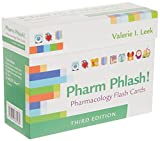
Focus on Pharmacology (8th Edition)
Focus on Nursing Pharmacology makes challenging concepts more approachable. Engaging learning features cultivate your clinical application, critical thinking and patient education capabilities. This updated 8th edition builds on your knowledge of physiology, chemistry and nursing fundamentals to help you conceptualize need-to-know information about each group of drugs.
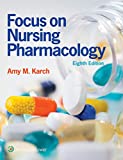
Pharmacology Made Incredibly Easy (Incredibly Easy! Series®)
Nursing pharmacology guide offers step-by-step guidance so you can grasp the fundamentals in enjoyable Incredibly Easy style. This is the perfect supplement to class materials, offering solid preparation for NCLEX® as well as a handy refresher for experienced nurses. Colorfully illustrated chapters offer clear, concise descriptions of crucial nursing pharmacology concepts and procedures.

Lehne’s Pharmacology for Nursing Care (11th Edition)
The Eleventh Edition of Lehne’s Pharmacology for Nursing Care provides a thorough understanding of key drugs and their implications for nursing care. This text, written by renowned nursing educators, helps you comprehend and apply pharmacology principles. A clear and engaging writing style simplifies complex concepts, making even the most challenging pharmacology content enjoyable. We recommend this book if you want a comprehensive nursing pharmacology guide.
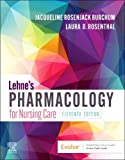
Nursing Drug Handbook
Nursing2023 Drug Handbook delivers evidence-based, nursing-focused drug monographs for nearly 3700 generic, brand-name, and combination drugs. With a tabbed, alphabetical organization and a “New Drugs” section, NDH2023 makes it easy to check drug facts on the spot.
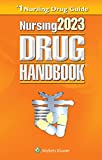
Pharmacology and the Nursing Process
The 10th edition of Pharmacology and the Nursing Process offers practical, user-friendly pharmacology information. The photo atlas contains over 100 unique illustrations and photographs depicting drug administration techniques. Updated drug content reflects the most recent FDA drug approvals, withdrawals, and therapeutic uses.
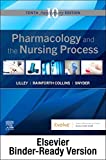
Mosby’s Pharmacology Memory NoteCards: Visual, Mnemonic, and Memory Aids for Nurses
The 6th edition of Mosby’s Pharmacology Memory NoteCards: Visual, Mnemonic, & Memory Aids for Nurses incorporates illustrations and humor to make studying easier and more enjoyable. This unique pharmacology review can be utilized as a spiral-bound notebook or as individual flashcards, making it ideal for mobile study.
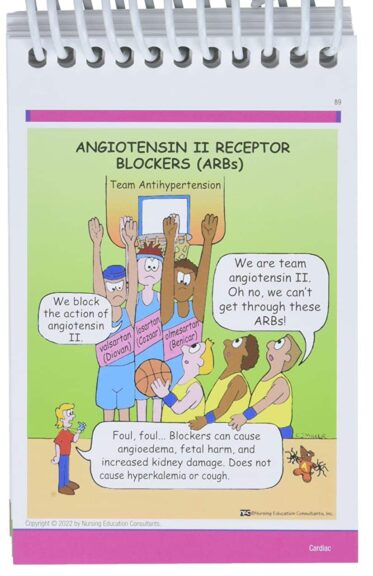
See Also
Here are other nursing pharmacology study guides:
- Nursing Pharmacology – Study Guide for Nurses
Our collection of topics related to nursing pharmacology - Pharmacology Nursing Mnemonics & Tips
These nursing mnemonics aim to simplify the concepts of pharmacology through the use of a simple, concise guide. - Generic Drug Name Stems Cheat Sheet
Learn about these generic drug name stems to help you make sense of drugs easier! - Common Drugs and Their Antidotes
A guide to drug antidotes that nurses should be familiar about. - IV Fluids and Solutions Guide & Cheat Sheet
Get to know the different types of intravenous solutions or IV fluids in this guide and cheat sheet. - Drug Dosage Calculations NCLEX Practice Questions (100+ Items)
Care to take the challenge? This quiz aims to help students and registered nurses alike grasp and master the concepts of medication calculation.
Drug Guides NEW!
Individual drug guides and nursing considerations for the most common medications used in nursing pharmacology:
- Acetaminophen (Tylenol)
- Aspirin
- Atorvastatin (Lipitor)
- Enoxaparin (Lovenox)
- Furosemide (Lasix)
- Gabapentin
- Hydromorphone (Dilaudid)
- Lisinopril
- Metoprolol
- Morphine
Gastrointestinal System Drugs
Respiratory System Drugs
- Antihistamines
- Bronchodilators and Antiasthmatics
- Decongestants
- Expectorants and Mucolytics
- Inhaled Steroids
- Lung Surfactants
Endocrine System Drugs
- Adrenocortical Agents
- Antidiabetic Agents
- Glucose-Elevating Agents
- Hypothalamic Agents
- Insulin
- Parathyroid Agents: Bisphosphonates, Calcitonins
- Pituitary Drugs
- Sulfonylureas
- Thyroid Agents
Autonomic Nervous System Drugs
- Adrenergic Agonists (Sympathomimetics)
- Adrenergic Antagonists (Sympatholytics)
- Anticholinergics (Parasympatholytics)
- Cholinergic Agonists (Parasympathomimetics)
Immune System Drugs
Chemotherapeutic Agents
- Anthelmintics
- Anti-Infective Drugs
- Antibiotics
- Antifungals
- Antineoplastic Agents
- Antiprotozoal Drugs
- Antiviral Drugs
Reproductive System Drugs
Nervous System Drugs
- Antidepressants
- Antiparkinsonism Drugs
- Antiseizure Drugs
- Anxiolytics and Hypnotic Drugs
- General and Local Anesthetics
- Muscle Relaxants
- Narcotics, Narcotic Agonists, and Antimigraine Agents
- Neuromuscular Junction Blocking Agents
- Psychotherapeutic Drugs
Cardiovascular System Drugs
References and Sources
References and sources for this pharmacology guide for Female Reproductive System Drugs:
- Karch, A. M., & Karch. (2011). Focus on nursing pharmacology. Wolters Kluwer Health/Lippincott Williams & Wilkins. [Link]
- Katzung, B. G. (2017). Basic and clinical pharmacology. McGraw-Hill Education.
- Lehne, R. A., Moore, L. A., Crosby, L. J., & Hamilton, D. B. (2004). Pharmacology for nursing care.
- Smeltzer, S. C., & Bare, B. G. (1992). Brunner & Suddarth’s textbook of medical-surgical nursing. Philadelphia: JB Lippincott.
